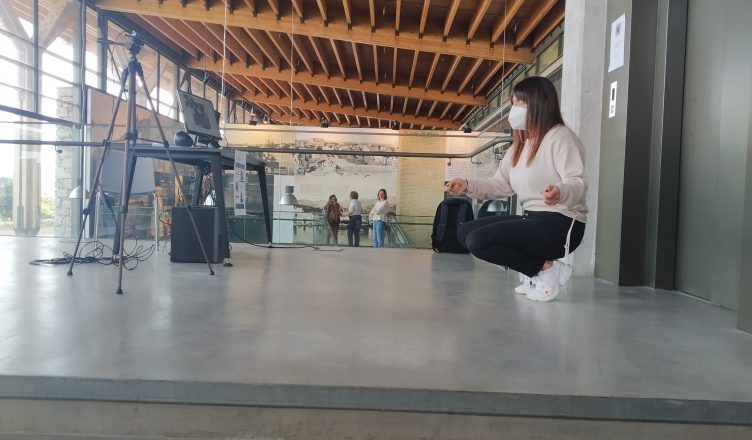Author: Danae Kaplanidi, scientific consultant, Piraeus Bank Group Cultural Foundation (PIOP)
Participating in the Mingei project led to the Chios Mastic Museum in Greece installing advanced applications that preserve and present the tangible and intangible elements of the heritage craft of mastic production. At the same time, these applications are designed to trial new and exciting ways to learn more about crafts through digital applications. Chios Mastic Museum asked itself: how can we ensure a positive experience for our museum professionals who demonstrate this advanced technology to visitors? Meeting a gap in existing research, this case study reports on what was learned for the benefit of other museums that consider installing digital applications.
About the Chios Mastic Museum
The Chios Mastic Museum is built in the Mastichohoria (mastic villages), a rural area in the south of the island of Chios. The museum replicates a mastic factory and consists of indoor and outdoor areas, including a mastic field. It is staffed by museum professionals and volunteers from the island. A typical day for the professionals responsible for the exhibition areas includes the opening of the exhibition (e.g. lights, audio-visual installations), keeping an eye on different exhibition areas, offering guided tours to groups and schools, and closing at the end of the day.
About the mastic digital applications
Three applications were created and installed during the Mingei project, and each application had to be introduced to and internalised by the museum professionals.
- Airborne, developed by FORTH, is an immersive flight simulator allowing users to fly over various mastic villages of Chios. During the flyover, users can stop at each village and retrieve multimedia and text information related to those villages. The setup is very straightforward: it involves a desktop computer.
- Mastic Narratives, also developed by FORTH, is made up of four tablet devices located in four main spots of the museum. From each tablet, a specific area of the museum is covered and augmented through the camera of the tablet with ‘hotspots’. At each hotspot, a Virtual Human (VH) appears who is the digital twin of someone who used to work in that part of the factory. When the hotspot is selected the VH can be seen through the camera of the tablet narrating their life story and work at the factory.
- ARMINES developed Craft Training which demonstrates mastic cultivation activities through a more immersive experience. The installation consists of a personal computer and a monitor together with a depth sensor for tracking the user’s actions. The user stands in front of the installation and follows the instructions to mimic craft actions.
Researching the experience of museum professionals with digital applications
We decided to research the experience of the museum professionals related to the digital applications recently installed in the museum through one of the Mingei Team-Based Inquiry cycles in March 2022.
We investigated a number of different areas relating to the museum staff’s experience of the advanced digital applications described above, including their:
- understanding of how the applications work
- opinion about this addition to their everyday tasks
- comfort in using the applications
- thoughts on more efficient ways to implement new digital applications in the exhibition
We conducted a focus group interview with museum professionals working directly with the applications in the exhibition areas.
What we learned
Experience and comfort in demonstrating using the applications
The results were very interesting and practical. The levels of comfort experienced by the museum professionals while using technology varied. All of them are open to technology but only one of them can be considered an expert and this is understandably the person that everyone turns to when there is a technical problem.
- The digital applications add value to the exhibition because they invite visitors to interact and learn about already existing information in a more playful way.
- The applications need improvement regarding their technical stability and how their instructions were communicated to the audience.
- They worry that during the summer they will face problems such as damage to the technical equipment and errors in the software because of overuse.
- They worry also that they might not explain correctly the context and content of the applications.
- Concerning their everyday tasks, there was no significant change and they are eager to learn more.
- They expressed that they understand how the applications work and feel comfortable to transmit this knowledge.
Ideas to help museum professionals feel comfortable with current and future digital applications in future
- Hold a demonstration at the same time as when the applications are installed in the museum.
- Create an accompanying PDF file with user and installation instructions, troubleshooting information and a contact in case of emergency, cleaning requirements, a break-down of daily tasks, and background information on the context, content and development of the application.
Next steps
Getting to know the perspective of what museum professionals feel about digital applications is an under-researched topic in an era where, especially after COVID-19, digital transformation is a pressing matter. The museum professionals of the Chios Mastic Museum are not software developers but are nonetheless intimately involved in the concept development of the applications, because they have the experience of interacting directly with the audience and knowing more about their reactions and needs. We wished to research their perspective to make it easier for them to work with advanced digital applications. Looking strategically forward, we will take into account more often museum professionals’ perspectives as a source of insight on how to create effective digital activities that meet the audience’s expectations.

